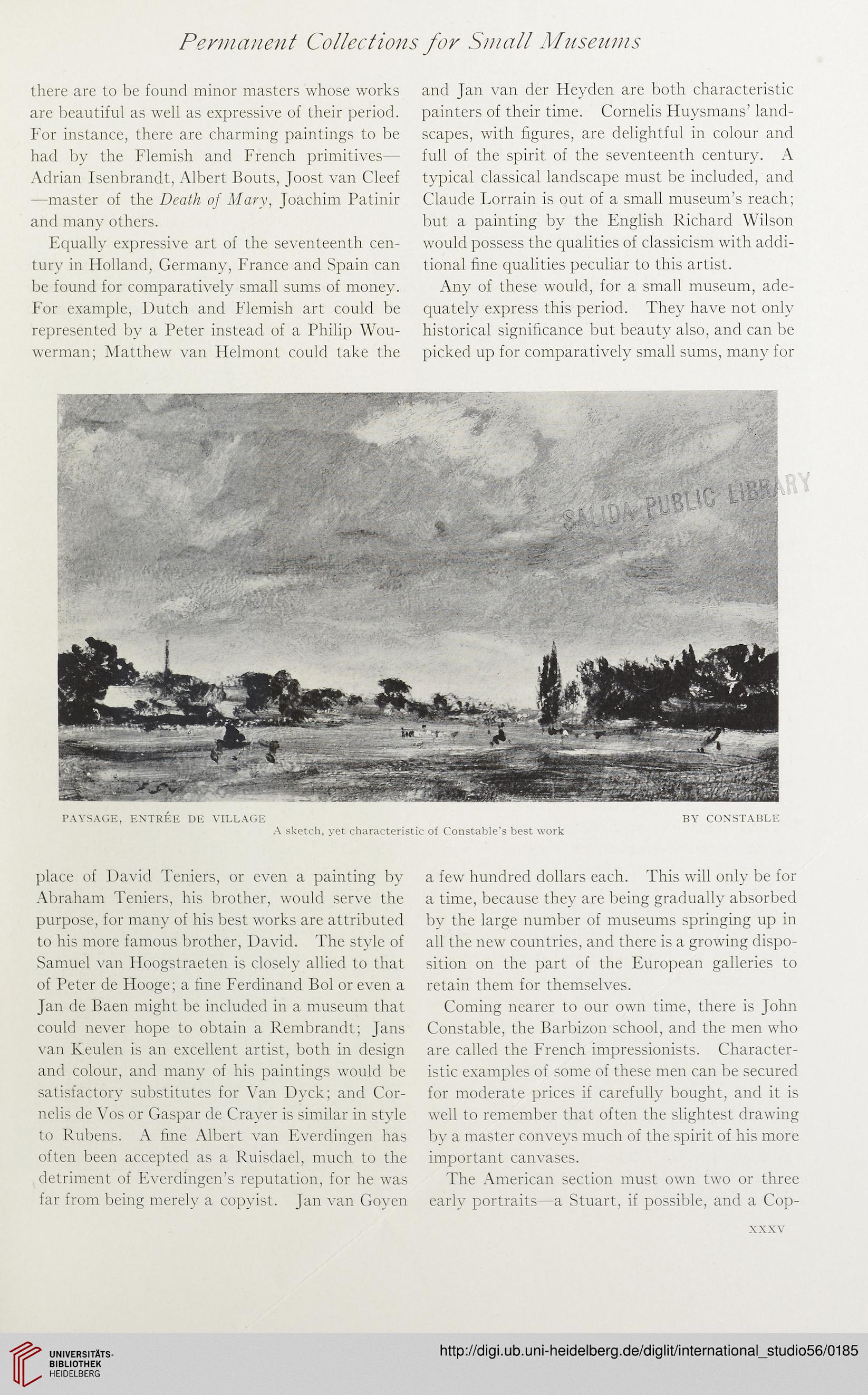Permanent Collections for Small Museums
there are to be found minor masters whose works
are beautiful as well as expressive of their period.
For instance, there are charming paintings to be
had by the Flemish and French primitives—
Adrian Isenbrandt, Albert Bouts, Joost van Cleef
—master of the Death of Mary, Joachim Patinir
and many others.
Equally expressive art of the seventeenth cen-
tury in Holland, Germany, France and Spain can
be found for comparatively small sums of money.
For example, Dutch and Flemish art could be
represented by a Peter instead of a Philip Wou-
werman; Matthew van Helmont could take the
and Jan van der Heyden are both characteristic
painters of their time. Cornells Huysmans’ land-
scapes, with figures, are delightful in colour and
full of the spirit of the seventeenth century. A
typical classical landscape must be included, and
Claude Lorrain is out of a small museum’s reach;
but a painting by the English Richard Wilson
would possess the qualities of classicism with addi-
tional fine qualities peculiar to this artist.
Any of these would, for a small museum, ade-
quately express this period. They have not only
historical significance but beauty also, and can be
picked up for comparatively small sums, many for
PAYSAGE, ENTREE DE VILLAGE BY CONSTABLE
A sketch, yet characteristic of Constable’s best work
place of David Teniers, or even a painting by
Abraham Teniers, his brother, would serve the
purpose, for many of his best works are attributed
to his more famous brother, David. The style of
Samuel van Hoogstraeten is closely allied to that
of Peter de Hooge; a fine Ferdinand Bol or even a
Jan de Baen might be included in a museum that
could never hope to obtain a Rembrandt; Jans
van Keulen is an excellent artist, both in design
and colour, and many of his paintings would be
satisfactory substitutes for Van Dyck; and Cor-
nelis de Vos or Gaspar de Crayer is similar in style
to Rubens. A fine Albert van Everdingen has
often been accepted as a Ruisdael, much to the
detriment of Everdingen’s reputation, for he was
far from being merely a copyist. Jan van Goyen
a few hundred dollars each. This will only be for
a time, because they are being gradually absorbed
by the large number of museums springing up in
all the new countries, and there is a growing dispo-
sition on the part of the European galleries to
retain them for themselves.
Coming nearer to our own time, there is John
Constable, the Barbizon school, and the men who
are called the French impressionists. Character-
istic examples of some of these men can be secured
for moderate prices if carefully bought, and it is
well to remember that often the slightest drawing
by a master conveys much of the spirit of his more
important canvases.
The American section must own two or three
early portraits—a Stuart, if possible, and a Cop-
xxxv
there are to be found minor masters whose works
are beautiful as well as expressive of their period.
For instance, there are charming paintings to be
had by the Flemish and French primitives—
Adrian Isenbrandt, Albert Bouts, Joost van Cleef
—master of the Death of Mary, Joachim Patinir
and many others.
Equally expressive art of the seventeenth cen-
tury in Holland, Germany, France and Spain can
be found for comparatively small sums of money.
For example, Dutch and Flemish art could be
represented by a Peter instead of a Philip Wou-
werman; Matthew van Helmont could take the
and Jan van der Heyden are both characteristic
painters of their time. Cornells Huysmans’ land-
scapes, with figures, are delightful in colour and
full of the spirit of the seventeenth century. A
typical classical landscape must be included, and
Claude Lorrain is out of a small museum’s reach;
but a painting by the English Richard Wilson
would possess the qualities of classicism with addi-
tional fine qualities peculiar to this artist.
Any of these would, for a small museum, ade-
quately express this period. They have not only
historical significance but beauty also, and can be
picked up for comparatively small sums, many for
PAYSAGE, ENTREE DE VILLAGE BY CONSTABLE
A sketch, yet characteristic of Constable’s best work
place of David Teniers, or even a painting by
Abraham Teniers, his brother, would serve the
purpose, for many of his best works are attributed
to his more famous brother, David. The style of
Samuel van Hoogstraeten is closely allied to that
of Peter de Hooge; a fine Ferdinand Bol or even a
Jan de Baen might be included in a museum that
could never hope to obtain a Rembrandt; Jans
van Keulen is an excellent artist, both in design
and colour, and many of his paintings would be
satisfactory substitutes for Van Dyck; and Cor-
nelis de Vos or Gaspar de Crayer is similar in style
to Rubens. A fine Albert van Everdingen has
often been accepted as a Ruisdael, much to the
detriment of Everdingen’s reputation, for he was
far from being merely a copyist. Jan van Goyen
a few hundred dollars each. This will only be for
a time, because they are being gradually absorbed
by the large number of museums springing up in
all the new countries, and there is a growing dispo-
sition on the part of the European galleries to
retain them for themselves.
Coming nearer to our own time, there is John
Constable, the Barbizon school, and the men who
are called the French impressionists. Character-
istic examples of some of these men can be secured
for moderate prices if carefully bought, and it is
well to remember that often the slightest drawing
by a master conveys much of the spirit of his more
important canvases.
The American section must own two or three
early portraits—a Stuart, if possible, and a Cop-
xxxv




